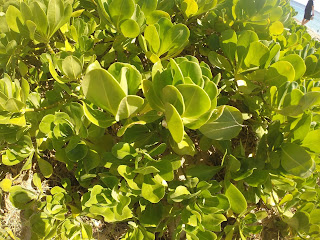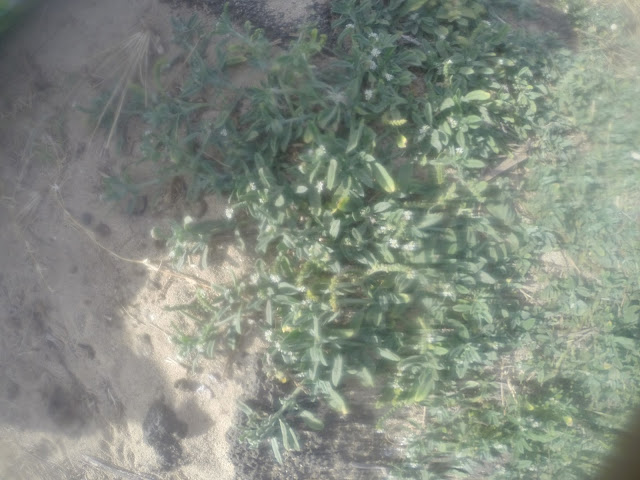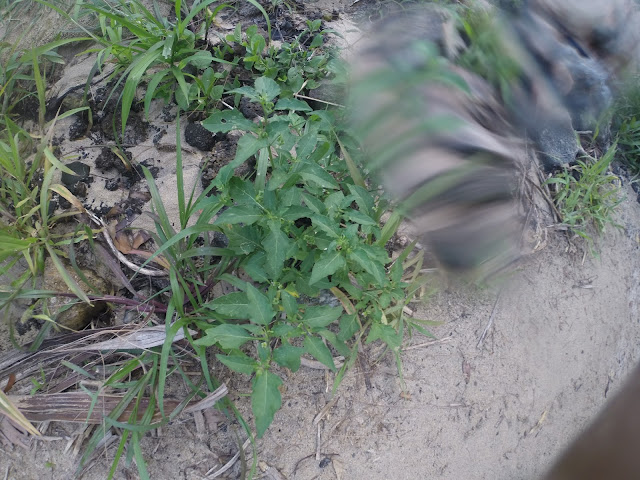Sandy Beach Park is located on the South Shore of Oahu. This spot is great for body-surfing and surfing at a more intermediate level. The first thing you'll notice when you arrive is that all the plants look like they are maintained and hedged. The grass is green and the trees are spaced out for shade over benches. On the beach itself, the flora looks a bit more natural. There are some species that I saw at the other previous sites, and some that I haven't seen yet.
There was a ton of Naupaka (Scaevola taccata) on the beach. These plants were everywhere. I'm starting to really get an idea of just how common they are in coastal areas.

This tree is one of the plants I couldn't identify in Waikiki at the "In-between". After talking to a friend who knows some botany, I learned that this is called the Norfolk Pine (
Araucaria heterophylla). These trees are closely related to the Cook's Pine (
Araucaria columnaris) and they can be mistaken for each other on the Hawaiian Islands. Both are non-natives and you can tell them apart based on some morphological features that are well presented
here.
Pigeons, or Rock Doves, (
Columba livia) were very common at Sandy Beach. They could be found on the grass by the parking lot and on the sand of the beach. Here in Hawai'i, the pigeons are commonly either grey (just like in mainland US cities) or white. These differences in color are known as morphs. Concerning safety, a study by Oshiro & Fujioka (1994) found that pigeon feces and mongoose feces can contribute to high bacteria levels in the water (The study was conducted at Hanauma Bay but it is possible that the same applies to other beaches such as Waikiki), so it is probably a good idea to wash your hands after going in the water.
Coconut palms (
Cocos nucifera) could be found on the beach around life guard towers and in the grassy field behind the beach. I talked about them a bit in the "In-between" post, so you can learn about them there. They are not native to Hawai'i.
Koa Haole (
Leucaena leucocephala) is common all over the island and I saw it before at Kaena.
Another banana spider (
Argiope appensa) like the ones I saw at Kaena. This is a female here. The banding isn't as clear on this individual but there are some white-grey bands that can be seen on the legs if you look closely.
The Zebra Dove (
Geopalia striata) is a common sight in urban areas. They can be found pretty much wherever pigeons are found. It's no surprise that they would be near a popular beach like Sandy.
This tree gave me some trouble. Using the guide books I have, my best guess is that this is a larger example of the Milo (
Thespesia populnea) like the one I saw at the In-between. However, the leaves are not quite as heart-shaped as the leaves from the other plant I saw before. In the second picture below is another plant that I believe resembles the milo more than this one, but I am not completely sure about that one either.
In the background are some Chinese Violets (
Asystasia gangetica) and in the foreground is a fuzzy plant that I couldn't identify. I haven't seen anything like it anywhere else on the island so far.
The Ironwood or Australian Pine (
Casuarina equisetifolia) is not a true pine, but it has become a fairly common plant, according to the Ecotourist guide. I haven't seen too many myself, but this is a good example of one that can be found here at Sandy Beach.
Taro (
Colocasia esculenta) is probably one of the most common plants on the Hawaiian Islands. It is a staple food crop that is used for local poi, which is like a taro paste. It is delicious when it is fresh but gets to be a bit sour tasting after a while. Taro is also a common flavor in many sweet foods such as frozen yogurt, bubble tea, etc.
Hala (
Pandanus tectorius) is a tree or shrub that is indigenous to Hawai'i. The fruits of these trees resemble pineapples. Their long, drooping leaves are their defining characteristic.
Mallard Ducks (
Anas platyrhynchos) can be found on all the islands near ponds and marshes much like on the mainland. Here they like to hang around shower area probably because it is the nearest source of freshwater.
Cattle Egrets
(Bubulcus ibis) are common on Manoa campus and in marshes or agricultural areas. These guys are probably here for the freshwater from the shower area much like the ducks.
The Spanish Needle (
Bidens pilosa). This is a weed that originated from the tropical Americas characterized by it's large white pedals and yellow flowers.
This appears to be a young False Kamani
(Terminalia catappa) growing up on the beach. Another one is pictured below near a bench with the more characteristic brown/yellow leaves mixed in with the green.
This plant is known at the nehe (
Melanthera integrifolia). It is a native plant.
Pili grass (
Heteropogon contortus) can be found in patches at Sandy Beach. This is a native grass to Oahu.
I saw some more Red-crested Cardinals (
Paroaria coronata) foraging near the beach in patches of grass. Previously, I saw this species at Kaena, but not at Waikiki. I'm not gonna say that they don't go to Waikiki, but perhaps the heavily maintained grounds by the hotel are not a good habitat for them.
Green algae covers lava rock out on the beach. I have heard that turtles like to eat this algae and so it is possible there may be turtles about wherever this algae is found. I didn't see any turtles, so I don't know how much truth there is to the story.
Summary:
Rating: 5/5
Sandy Beach Park was a nice place to spend the afternoon. There are a number of endemic/native species here, but there are also tons of non-natives/invasives. I encountered many of these species either at Waikiki or Kaena. I'm starting to see that the coastal strand on O'ahu is somewhat homogenous with some subtle differences depending on the location. So far the presence of coconuts and pigeons seem to be restricted to popular or "touristy" beaches as there weren't any at Kaena. I will have to see if that holds up as I continue onwards. Better than Waikiki but not as unique and interesting as Kaena. This spot is great for relaxing or getting in the water if you are a strong swimmer. It is recommended that you use fins to swim or body surf since the waves and current can be strong.
Journal Citation:
Oshiro, R., & Fujioka, R. (1995). Sand, soil, and pigeon droppings: Sources of indicator bacteria in the waters of Hanauma bay, Oahu, Hawaii. Water Science and Technology, 31(5–6), 251–254. http://doi.org/10.1016/0273-1223(95)00275-R
Web Citation:
"The World´s Tree Species: Norfolk Island Pine vs. Cook Pine." The World´s Tree Species: Norfolk Island Pine vs. Cook Pine. Blogger, Dec. 2007. Web. 10 Mar. 2016.




































































